Punch Card Data Processing
From the 1890 U.S. Census until into the 1990s the Punch Card played a significant role in the processing of data. The beginning of the end was heralded in the 1960s, when alternative storage media were developed and computer terminals, talking directly to the mainframe, began to appear. The 1970s saw a rapid rise in video display terminals, connected via Control Units, or Concentrators, to mainframe systems. This web page takes a look at some of the equipment and processes involved, with much of the hardware discussed on display in the museum.
The museum has produced a trifold briefly covering the story of the punch card, with another planned to provide an overview of the processes described here.. This is an 'expanded' version of that story, using a typical scenario, and giving the wider history of this key component in the development of data processing systems. Where appropriate there are links to more comprehensive information here or on external sites.
In the Beginning
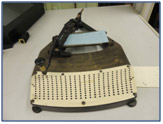 The US census of 1880 had taken about 8 years to process. A faster method was needed, so in the second half of the 1880s Herman Hollerith, who had worked on the 1880 census, began thinking about how that might be accomplished. His efforts won him the contract for the 1890 census.
The US census of 1880 had taken about 8 years to process. A faster method was needed, so in the second half of the 1880s Herman Hollerith, who had worked on the 1880 census, began thinking about how that might be accomplished. His efforts won him the contract for the 1890 census.
 He experimented first with paper tape, but then decided to try using punch cards, first pioneered in the Jacquard Loom. His first attempt used a punch similar to that of a tram or train conductor, punching round holes around the outside of the card. This was prone to inaccuracies and was very slow, so he eventually came up with the idea of the pantograph punch. There were 12 rows and 20, 22 or 24 columns. Hursley’s pantograph card punch has 22 columns and is date stamped 1889. We believe a 20 column version was used for the census although other sources claim 24 columns.
He experimented first with paper tape, but then decided to try using punch cards, first pioneered in the Jacquard Loom. His first attempt used a punch similar to that of a tram or train conductor, punching round holes around the outside of the card. This was prone to inaccuracies and was very slow, so he eventually came up with the idea of the pantograph punch. There were 12 rows and 20, 22 or 24 columns. Hursley’s pantograph card punch has 22 columns and is date stamped 1889. We believe a 20 column version was used for the census although other sources claim 24 columns.
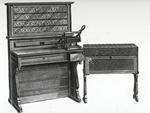 Census forms were transcribed onto a punch card for each person. The information needed to be turned into meaningful data, and for this Hollerith designed his Tabulator. Cards were manually inserted one at a time and the holes 'read' by probing with spring-loaded wires. Where there was a hole, the probe would continue down until it dipped into a pool of mercury, completing an electrical circuit and incrementing one of the dial counters. The accompanying sort box could be set up to flip open a lid on one of the pockets. Usually at the end of the day the counters would be read, reset to zero and the results written down.
Census forms were transcribed onto a punch card for each person. The information needed to be turned into meaningful data, and for this Hollerith designed his Tabulator. Cards were manually inserted one at a time and the holes 'read' by probing with spring-loaded wires. Where there was a hole, the probe would continue down until it dipped into a pool of mercury, completing an electrical circuit and incrementing one of the dial counters. The accompanying sort box could be set up to flip open a lid on one of the pockets. Usually at the end of the day the counters would be read, reset to zero and the results written down.
Reports vary on just how much time was saved. Some sources claim the count took as little as 6 weeks, others up to 3 years. It is known that a straightforward count of the population without any in-depth analysis was published only six weeks after the count had started; the result was 62,622,250. Although the overall costs were somewhat higher than 10 years previously, estimates show savings to US taxpayers of USD 5 million. The discrepancies did initially cast doubts on the future of census automation, but this was eventually put down to running a far more comprehensive process than in previous years. Whatever the actual number, Hollerith's card punch and tabulator were a huge success, and before 1890 was out he received orders from Austria, Russia, Canada and France, with other countries following suit in subsequent years.
More background on Hollerith can be found here on Columbia University's web site, together with some further useful links. There is also a comprehensive analysis of the process here and an excellent history of the early days leading up to the 1890 census on the History-Computer site.
Hollerith's Tabulating Machine Company and two other companies, International Time Recorders (ITR) and the Computing Scale Company (CSC), were brought together in 1911 to form the Computing, Tabulating and Recording Company (CTR). A fourth company, Bundy Manufacturing, was also incorporated into the new organisation but did not feature in the name. CTR was renamed International Business Machines (IBM) in 1924. The Tabulating Machine Company part of this new enterprise formed the basis of the IBM company we know today.
The Rise of Unit Record
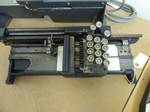 Hollerith's success spurred him on to further developments. He designed a new card punch, the 001 hand punch, which was released in 1901. It had a mechanical push-down key for each of the 12 card rows and a mechanism to move the card automatically one column at a time as each one was punched. It was twice as fast at producing punched cards than the pantograph punch. Additional functions were added to his tabulator, the ability to perform addition widened the applicability to other fields. New hardware developments continued; automatic card feeding, reading cards that were in motion, more complex arithmetic functions, programmability via patch panels and switch banks, printed output, punch card output and a standard card format all contributed to rapid growth.
Hollerith's success spurred him on to further developments. He designed a new card punch, the 001 hand punch, which was released in 1901. It had a mechanical push-down key for each of the 12 card rows and a mechanism to move the card automatically one column at a time as each one was punched. It was twice as fast at producing punched cards than the pantograph punch. Additional functions were added to his tabulator, the ability to perform addition widened the applicability to other fields. New hardware developments continued; automatic card feeding, reading cards that were in motion, more complex arithmetic functions, programmability via patch panels and switch banks, printed output, punch card output and a standard card format all contributed to rapid growth.
 Until the invention of the electronic computer, these electromechanical machines, which became known collectively as Unit Record equipment, were at the heart of data processing operations. Initially card feeding was done manually. This was soon replaced by mechanical feed mechanisms, which could read cards while they were moving, and which developed eventually to reach speeds of 2,000 cards per minute. Printing the output from the tabulator was introduced in the 1920s.
Until the invention of the electronic computer, these electromechanical machines, which became known collectively as Unit Record equipment, were at the heart of data processing operations. Initially card feeding was done manually. This was soon replaced by mechanical feed mechanisms, which could read cards while they were moving, and which developed eventually to reach speeds of 2,000 cards per minute. Printing the output from the tabulator was introduced in the 1920s.
 As processing needs grew more complex, higher capacity punch cards were needed and the card format changed in 1928 to rectangular holes with 80 columns per IBM card. New or modified machines were introduced to handle this more dense format, often with more complex capabilities, including removable plug boards (control panels) essential in allowing a level of programming control. By the late 1930s, electronic components first appeared and were in general use by the late 40s. External design moved from crude frameworks and exposed moving parts to heavy, cast-iron machines with Queen Ann legs to pressed steel, cleaner lines and wheels. Naturally, other manufacturers set up to support this growing industry too. Wikipedia has a list of some of the major developments here. The punch card itself became a major revenue earner for IBM, generating about 25% of the company's profits during the 1930s.
As processing needs grew more complex, higher capacity punch cards were needed and the card format changed in 1928 to rectangular holes with 80 columns per IBM card. New or modified machines were introduced to handle this more dense format, often with more complex capabilities, including removable plug boards (control panels) essential in allowing a level of programming control. By the late 1930s, electronic components first appeared and were in general use by the late 40s. External design moved from crude frameworks and exposed moving parts to heavy, cast-iron machines with Queen Ann legs to pressed steel, cleaner lines and wheels. Naturally, other manufacturers set up to support this growing industry too. Wikipedia has a list of some of the major developments here. The punch card itself became a major revenue earner for IBM, generating about 25% of the company's profits during the 1930s.
Unit Record Workflow - Punching and Verifying
 Processing the 1890 census began with transcribing the information from the completed census forms to punch cards, one card representing each line, or person, on the form. From then on, this same process of transcribing input documents to punch cards continued through into the 1970s (and sometimes on into the 1990s), until it became possible to transfer information directly into the mainframe, or indeed to process a job locally on a PC. Input documents would cover the huge range of tasks from industry, commerce, banking, government, from orders to payroll to social security and tax and everything in between. Even computer programmers had first to write their lines of code onto a coding sheet.
Processing the 1890 census began with transcribing the information from the completed census forms to punch cards, one card representing each line, or person, on the form. From then on, this same process of transcribing input documents to punch cards continued through into the 1970s (and sometimes on into the 1990s), until it became possible to transfer information directly into the mainframe, or indeed to process a job locally on a PC. Input documents would cover the huge range of tasks from industry, commerce, banking, government, from orders to payroll to social security and tax and everything in between. Even computer programmers had first to write their lines of code onto a coding sheet.

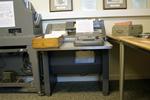 The process started when the job owner finished putting the job together and sent it to the punch room, perhaps in a job tray similar to that shown here. A typical process flow is described in the following paragraphs using the last iteration, before its demise, of unit record hardware from the 1940s and 1950s. The card punch operator punched the information from the input documents into the cards. The IBM hardware of the 40s and 50s was the 024 card punch and 026 printing card punch. The latter was able to print above each column what was punched there. Typically, larger installations would minimise their monthly rental costs by using non-printing punches, and where it was desirable to have printed information would rent additional hardware, known as Interpreters, to do that job separately.
The process started when the job owner finished putting the job together and sent it to the punch room, perhaps in a job tray similar to that shown here. A typical process flow is described in the following paragraphs using the last iteration, before its demise, of unit record hardware from the 1940s and 1950s. The card punch operator punched the information from the input documents into the cards. The IBM hardware of the 40s and 50s was the 024 card punch and 026 printing card punch. The latter was able to print above each column what was punched there. Typically, larger installations would minimise their monthly rental costs by using non-printing punches, and where it was desirable to have printed information would rent additional hardware, known as Interpreters, to do that job separately.
 Once the job (or batch if part of a larger job) was completed , the job tray was then given to a verifier operator, who typed the same information as the punch operator to check for errors. The 056 card verifier looked externally very much like its companion card punch. The punch unit was replaced by a verify unit, mechanically very similar but with rectangular pins instead of punches that would complete an electrical circuit when they sensed a hole. The hole position was compared to the key that was pressed by the verifier operator. Good cards with all columns correct received a semicircular notch at the right-hand end. If the operator pressed an incorrect key they were given three attempts to press the correct key. On the third attempt the incorrect column in the card was marked with a semicircular notch above it. Once all cards were verified, the job went back to the punch operator to re-punch any incorrect cards then the card deck went back to the verifier operator for the previously incorrect cards to be re-verified.
Once the job (or batch if part of a larger job) was completed , the job tray was then given to a verifier operator, who typed the same information as the punch operator to check for errors. The 056 card verifier looked externally very much like its companion card punch. The punch unit was replaced by a verify unit, mechanically very similar but with rectangular pins instead of punches that would complete an electrical circuit when they sensed a hole. The hole position was compared to the key that was pressed by the verifier operator. Good cards with all columns correct received a semicircular notch at the right-hand end. If the operator pressed an incorrect key they were given three attempts to press the correct key. On the third attempt the incorrect column in the card was marked with a semicircular notch above it. Once all cards were verified, the job went back to the punch operator to re-punch any incorrect cards then the card deck went back to the verifier operator for the previously incorrect cards to be re-verified.
Both punch and verifier had programming capabilities using a punch card wrapped around a programme drum. Programmable functions were duplicate or skip columns and force alpha or numeric columns. Columns could be duplicated from the previous card, which was read by the 'pin sensing unit' located between the punch / verify station and the card stacker, either automatically or manually. The latter was useful when the punch operator was correcting cards, duplicating up to the error then to the end afterwards.
Workflow - Interpreting
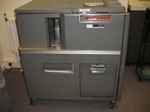 Whilst some experienced operators could read a punch card without any printing, most people could not. If the cards were punched on a non-printing punch, they could be printed using an Interpreter. The 557 Interpreter read the cards as they were fed and set up a set of 60 print wheels to print along the top of the card.
Whilst some experienced operators could read a punch card without any printing, most people could not. If the cards were punched on a non-printing punch, they could be printed using an Interpreter. The 557 Interpreter read the cards as they were fed and set up a set of 60 print wheels to print along the top of the card.
There were only 60 print positions to allow room for the various racks and gears that rotated them. Using the Control Panel, the operator set up which columns printed where - printing wasn't necessarily in the same position as the punch holes. Printing could also be continued on a second line by feeding the cards through again, to allow all 80 columns to be printed.
Another Interpreter of the time was the 548, which used vertical typebars instead of print wheels.
Workflow - Sorting
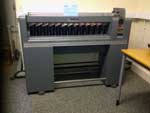 Once the deck of cards was correct, with all cards notched at the right-hand end, they would then typically pass through a series of operations on the various Unit Record machines prior to final processing. In this example, we follow a typical customer invoicing job. The punch cards contain information on customer orders, with fields for customer number, part number, description, quantity and price per unit. Assuming that the input documents had not been sorted by customer number, the cards needed to be sorted one column at a time on a card sorter until they were in groups sequenced by that number.
Once the deck of cards was correct, with all cards notched at the right-hand end, they would then typically pass through a series of operations on the various Unit Record machines prior to final processing. In this example, we follow a typical customer invoicing job. The punch cards contain information on customer orders, with fields for customer number, part number, description, quantity and price per unit. Assuming that the input documents had not been sorted by customer number, the cards needed to be sorted one column at a time on a card sorter until they were in groups sequenced by that number.
The machine for this job was the 082 Card Sorter. This machine was made up of a card hopper, from which cards were fed through a read station then on into the stacker corresponding to the hole punched in the card column being sorted. A single steel filament brush in contact with a bronze roller the full width of the machine was insulated by the card being fed until a hole was sensed. The brush contacting the roller then diverted the card to the correct stacker. To sort alpha columns the cards needed to pass through twice on the same column. The 082 could sort up to 600 cards per minute. Later sorters like the 084 could sort 2000 cards per minute.
Workflow - Reproducing
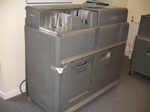 Just as today we make a backup of our data (hopefully) so in some cases a duplicate set of cards might be needed. For example, in the following stage, customer address cards are merged with customer orders. Rather than reverse the merge after processing, a duplicate set of customer cards might be made and put into storage for the next time. This is our customer database and was reproduced on an IBM 519, variously called a Reproducing Punch, Gang Punch or Document Originating Machine - more on the latter title later. Other similar hardware of the day was the 514.
Just as today we make a backup of our data (hopefully) so in some cases a duplicate set of cards might be needed. For example, in the following stage, customer address cards are merged with customer orders. Rather than reverse the merge after processing, a duplicate set of customer cards might be made and put into storage for the next time. This is our customer database and was reproduced on an IBM 519, variously called a Reproducing Punch, Gang Punch or Document Originating Machine - more on the latter title later. Other similar hardware of the day was the 514.
For the database, the control panel is simply wired for a one to one reproduction. One of the two hoppers contained the punched cards, the other a deck of blank cards. The 519 could also be configured to punch the output cards in different formats and to do other minor processing tasks. It could also be used to read cards and feed the data into a tabulator for final processing, or take the output data from a tabulator and punch a deck of cards from it.
Workflow - Collating
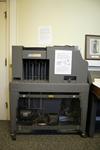 Our customer order cards don't contain the customer’s address, which needs to be printed on the paper invoice. The customer database card deck was previously sorted in the same customer number order as the actual order cards. The 077 Collator was set up using the control panel to merge the two decks of cards. The two decks were placed in the two hoppers. First, an order card was read and held. Customer cards were read until the one matching the order is found. Non-matching cards were dropped into one of the four stackers. The matching customer card went into another stacker, followed by all of the cards matching the customer number. As soon as a non matching order card was read, it was held while the customer cards were again read. This continued until the deck to be processed contained a customer card followed by customer orders for all of the orders.
Our customer order cards don't contain the customer’s address, which needs to be printed on the paper invoice. The customer database card deck was previously sorted in the same customer number order as the actual order cards. The 077 Collator was set up using the control panel to merge the two decks of cards. The two decks were placed in the two hoppers. First, an order card was read and held. Customer cards were read until the one matching the order is found. Non-matching cards were dropped into one of the four stackers. The matching customer card went into another stacker, followed by all of the cards matching the customer number. As soon as a non matching order card was read, it was held while the customer cards were again read. This continued until the deck to be processed contained a customer card followed by customer orders for all of the orders.
Mark Sense and Port-A-Punch

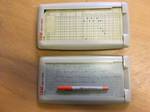 In some applications it was possible to short circuit the punching process. For example, IBM Customer Engineers used mark sense cards to complete a call report card for each repair. Report cards were pre-punched with machine serial number and customer number information, and contained mark sense fields which the CE completed using a graphite pencil. The CE completed the code for the type of call and the time spent and submitted the cards each week to the branch office. They were then fed through a punch machine such as the 519, which had special brushes that could read the graphite marks and punch the appropriate fields in the card.
In some applications it was possible to short circuit the punching process. For example, IBM Customer Engineers used mark sense cards to complete a call report card for each repair. Report cards were pre-punched with machine serial number and customer number information, and contained mark sense fields which the CE completed using a graphite pencil. The CE completed the code for the type of call and the time spent and submitted the cards each week to the branch office. They were then fed through a punch machine such as the 519, which had special brushes that could read the graphite marks and punch the appropriate fields in the card.
Another piece of equipment was the Port-A-Punch. This used punch cards that had all of the possible punch positions scored. The card was inserted in the punch, and a stylus used to push the pre-scored card chip out. They were particularly useful for applications such as taking inventory, creating job cards or performing statistical surveys. There was no need for any interim paperwork.
Workflow Processing - The Tabulator
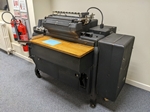 The final step in our customer invoicing job was to read the prepared card deck and print the invoices. The control panel, and sometimes additional hard-wired switches, were configured in our case to read the customer data card and print the customer name, address and customer number on the invoice. Then each order card was read and the item number, name, unit price and quantity printed. The Tabulator then calculated the total price for the item and printed it,
The final step in our customer invoicing job was to read the prepared card deck and print the invoices. The control panel, and sometimes additional hard-wired switches, were configured in our case to read the customer data card and print the customer name, address and customer number on the invoice. Then each order card was read and the item number, name, unit price and quantity printed. The Tabulator then calculated the total price for the item and printed it, 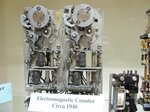 keeping note of that figure to be added to all of the other item totals for a grand total. Each order item was printed on a new line, and when a new customer data card was read the card reading paused. The tabulator calculated the total price, then any sales tax using defaults set by the control panel and a grand total before moving to the next invoice. The museum's tabulator is the IBM 416 dating from 1941.
keeping note of that figure to be added to all of the other item totals for a grand total. Each order item was printed on a new line, and when a new customer data card was read the card reading paused. The tabulator calculated the total price, then any sales tax using defaults set by the control panel and a grand total before moving to the next invoice. The museum's tabulator is the IBM 416 dating from 1941.
There were several tabulators from the 40s and 50s including the 421 and 444. These machines used electromechanical counters and relays for all of their calculations. Decimal currency calculations were relatively straightforward, but UK Sterling with 12 pence in a shilling and 20 shillings in a pound produced some interesting hardware workarounds.
Many tabulators could be connected to external devices. A typical installation might have connected the 519 to be used both to read in the card jobs for processing and punching a card deck of the output if that were required for backup. This gave rise to the name "Document Originating Machine."
Workflow Processing - The Mainframe
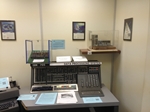 The 1950s saw the appearance of the first commercial mainframes. They were very expensive and out of reach of all but the bigger customers, where they were able to assume the role of much of the unit record hardware. Now it was possible to read the punch cards and store the customer database onto magnetic tape. Similarly the customer jobs could be read onto tape, then the processes previously undertaken by the sorter and collator could be managed at electronic speed. The tabulator's role was also superseded, with high speed printers and output card punches taking over. The museum's 705 console was the operator's interface to the processor and peripherals, and there is a model showing the computer room layout on display alongside it. This particular computer was used to process payroll for the whole of the UK Army, and was also seconded to the government to process the 1961 UK census.
The 1950s saw the appearance of the first commercial mainframes. They were very expensive and out of reach of all but the bigger customers, where they were able to assume the role of much of the unit record hardware. Now it was possible to read the punch cards and store the customer database onto magnetic tape. Similarly the customer jobs could be read onto tape, then the processes previously undertaken by the sorter and collator could be managed at electronic speed. The tabulator's role was also superseded, with high speed printers and output card punches taking over. The museum's 705 console was the operator's interface to the processor and peripherals, and there is a model showing the computer room layout on display alongside it. This particular computer was used to process payroll for the whole of the UK Army, and was also seconded to the government to process the 1961 UK census.

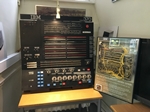 The mid-1960s saw the IBM System/360 revolution, with many different and ever more powerful central processor units able for the first time to share the same peripherals and software. Customers could upgrade their systems without having to change either peripherals or software. Disk drives allowed high-speed storage and retrieval of data. Customer jobs went from punch room straight to the computer room, with the accompanying reduction in processing time. System/360 was superceded by System/370, with both watching over the slow demise of the punch card. Hursley contributed to both programmes, developing the S/360 Models 40 & 44 and the S/370 Model 138.
The mid-1960s saw the IBM System/360 revolution, with many different and ever more powerful central processor units able for the first time to share the same peripherals and software. Customers could upgrade their systems without having to change either peripherals or software. Disk drives allowed high-speed storage and retrieval of data. Customer jobs went from punch room straight to the computer room, with the accompanying reduction in processing time. System/360 was superceded by System/370, with both watching over the slow demise of the punch card. Hursley contributed to both programmes, developing the S/360 Models 40 & 44 and the S/370 Model 138.
The 80 Column Punch Card Format
The IBM 80 column punch card's physical size lent itself to a variety of other formats, such as airline tickets and boarding cards, cheques, pay slips and more. Even the first magnetic cards used with the Magnetic Card Selectric Typewriter were physically the same size as the IBM Card, as well as flexible memory elements such as CCROS (Card Capacitor Read Only Storage). 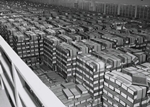
Each punch card offered a maximum of 80 columns, or bytes. One card box typically contained 2,000 cards for a maximum of 160K bytes, 6.1/4 boxes per Megabyte, or 625 boxes per 100M. The photograph shows the sheer volume required to store data, here approximately 4GB of data storage.
The Beginning of the End of the Punch Card
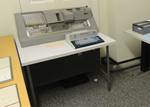
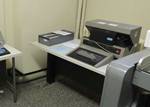 Punch card machine development continued in the early 1960s with the introduction of the 029 punch and 059 verifier in 1964 as part of the System/360 development. Restyled covers contained basically the same card feed, transport and stacker components as the earlier 1940s design, but with upgraded electronics using transistors, reed relays and fibre optics. The 129 data recorder continued that development in 1970 as a combined punch and verifier. It allowed the data to be 'punched' and 'verified' in memory before the actual card was punched. There was even an effort in 1969 by the General Systems Division to change the punch card to a smaller format but with 96 columns instead of 80. The 5496 data recorder, like the 129, could both punch and verify
Punch card machine development continued in the early 1960s with the introduction of the 029 punch and 059 verifier in 1964 as part of the System/360 development. Restyled covers contained basically the same card feed, transport and stacker components as the earlier 1940s design, but with upgraded electronics using transistors, reed relays and fibre optics. The 129 data recorder continued that development in 1970 as a combined punch and verifier. It allowed the data to be 'punched' and 'verified' in memory before the actual card was punched. There was even an effort in 1969 by the General Systems Division to change the punch card to a smaller format but with 96 columns instead of 80. The 5496 data recorder, like the 129, could both punch and verify 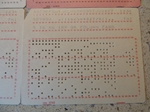 these cards in memory prior to punching, for data entry into the IBM System/3 mid-range computing system.
these cards in memory prior to punching, for data entry into the IBM System/3 mid-range computing system.
 In the second half of the 60s, alternative media began to be used in place of the punch card. Other companies offered data entry machines that recorded the data in punch card format on magnetic tape reels.
In the second half of the 60s, alternative media began to be used in place of the punch card. Other companies offered data entry machines that recorded the data in punch card format on magnetic tape reels. 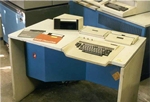 These could then be loaded directly onto a tape unit in the machine room. The IBM 050 was announced in 1968. This transcribed the 80 column data directly to magnetic tape in small, rectangular cartridges.
These could then be loaded directly onto a tape unit in the machine room. The IBM 050 was announced in 1968. This transcribed the 80 column data directly to magnetic tape in small, rectangular cartridges.
The 3740 series was announced in 1973, using the new 8” floppy disks.
 In 1965 IBM announced the 2740 and 2741 data terminals. These consisted of a Selectric I/O (Input / Output) Golf Ball Typewriter with logic circuitry to connect to a mainframe via a modem. This was the start of direct user data entry to, and interaction with, the mainframe. This was followed by other faster terminals such as the 3767, which used an early dot matrix printer.
In 1965 IBM announced the 2740 and 2741 data terminals. These consisted of a Selectric I/O (Input / Output) Golf Ball Typewriter with logic circuitry to connect to a mainframe via a modem. This was the start of direct user data entry to, and interaction with, the mainframe. This was followed by other faster terminals such as the 3767, which used an early dot matrix printer. 
Then in 1971 the 3277 display terminal was introduced. These could be connected locally to a controller, which in turn routed the data to and from the mainframe, either directly connected to the mainframe channel (bus) or remotely through a modem. All of these products continued to follow the punch card 80 column format for data entry, although later display terminal screens began to be formatted for more user-friendly data input. 3277 gave way to 3278 in 1977.
 In 1979 the colour revolution began with the first-ever colour terminal, the 3279, developed in Hursley. The 3279 was developed in Hursley and manufactured in Greenock, Scotland. Depending upon model, it could display four or seven colours and graphics.
In 1979 the colour revolution began with the first-ever colour terminal, the 3279, developed in Hursley. The 3279 was developed in Hursley and manufactured in Greenock, Scotland. Depending upon model, it could display four or seven colours and graphics.
In conjunction with Hursley developed mainframe based GDDM (Graphical Data Display Manager) and GDDM's Interactive Chart Utility, the 3279 brought business graphics to the desktop for the first time.
The End was a slow process of evolution as customers invested in newer IT infrastructure. There were still mainframe installations using punch cards for input into the 80s, and it is possible they may have survived even longer.
This has been a snapshot of just some of the hundreds of machines and systems that IBM produced over the years and how they were typically used. You can view a list of all IBM hardware, when it was announced and when it was withdrawn, up to 1987, here. We also have a list of Hursley developed hardware here.

